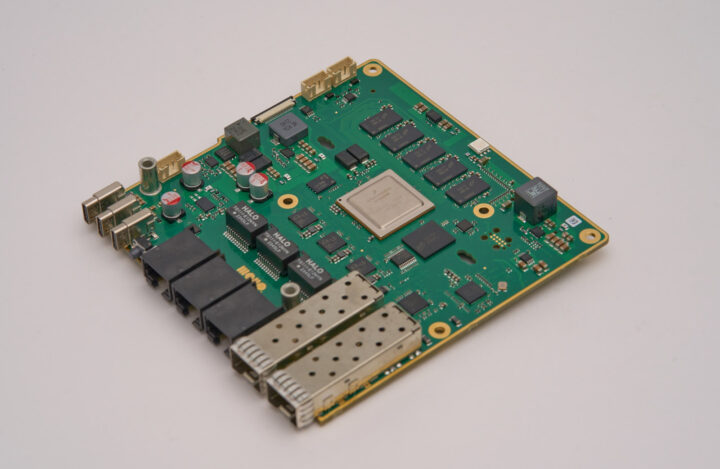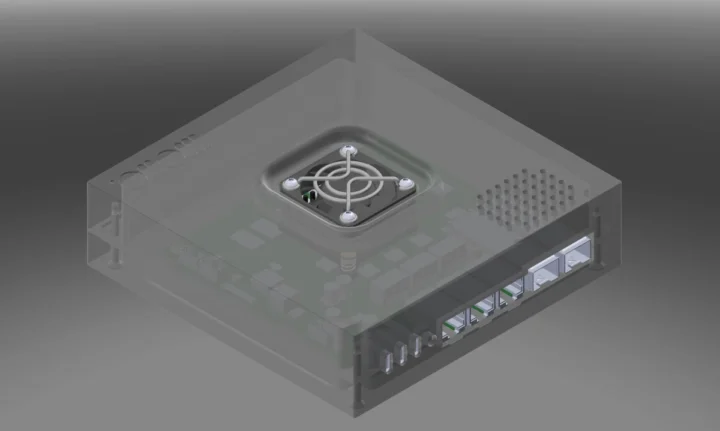The Mono Gateway is a nano-ITX router board powered by an NXP LayerScape LS1046A quad-core processor and equipped with two 10GbE SFP+ cages, three gigabit Ethernet RJ45 ports, and M.2 sockets for wireless WiFi 6 and/or tri-band WiFi 5, Bluetooth, and Thread modules.
Toma Zaman’s YouTube channel description reads “I hate routers”, and that’s exactly why the “Gateway” came to life. He wanted a router that meets his expectations and runs open-source software. The NXP Layerscape LS1046A was selected thanks to its ability to support 10 Gbps Ethernet with up to 26 Gbps line-rate throughput for VLANs, PPPoE, and NAT. Let’s have a look.
Mono Gateway specifications:
- SoC – NXP Layerscape LS1046A quad-core Cortex-A72 processor @ 1.6 GHz
- System Memory – 8 GB ECC RAM @ 2100 MT/s
- Storage
- 32 GB eMMC flash for the OS
- 64 MB NOR flash for the bootloader
- Networking
- 2x SFP+ 10 Gbps Ethernet cages
- 3x Gigabit Etherner RJ45 ports
- Optional WiFi 6 2×2 MU-MIMO via M.2 Key-E module
- Optional Tri-radio WiFi 5.0, Bluetooth, Thread via (another) M.2 Key-E module
- USB – 1x USB 3.0 Type-C port
- Debugging
- JTAG connector
- 100+ test points throughout the PCB
- 8x power sensors and 2x temperature sensors for real-time system insights
- UART USB-C port
- Misc – Status RGB LED, active cooling via 2x 2-pin 5V PWM fan headers
- Power Supply – USB-C PD 3.0; 65W charger provided
- Dimensions
- Board – 120 x 120 mm (Nano-ITX form factor)
- Polycarbonate enclosure – TBD
We’re also told the router runs OpenWrt, and Linux distributions as well as networking-specific operating systems (VyOS) and technologies (VPP + DPDK) will also be supported. But apart from that, there’s limited information on the project’s website. Having said that, the LS1046A is an older SoC introduced in 2016, and the NXP LS1046A reference developer board is also supported in OpenWrt, so I would not worry too much about software support. For reference, we also covered some other LS1046A hardware platforms in the past, such as the Forlinx OK1046A-C networking SBC and Conclusive Engineering WHLE-LS1046A.
If you like video content, Toma Zaman is providing regular updates on his YouTube channel. The project started over a year ago, and it’s getting closer to completion. I’ve included one of the more recent updates below.
The Mono Gateway 10GbE Nano-ITX router board is still considered a development kit without price optimization. People who want to get a sample can pay a $100 reservation fee before purchasing the board for $600, and get it shipped between June and September 2025. If I understand correctly, there will eventually be a “Founders Edition” with a CNC-milled aluminium enclosure and a “Rackmount Edition” with a sheet metal enclosure that may be slightly cheaper once launched.
Thanks to Sebastian for the tip.

Jean-Luc started CNX Software in 2010 as a part-time endeavor, before quitting his job as a software engineering manager, and starting to write daily news, and reviews full time later in 2011.
Support CNX Software! Donate via cryptocurrencies, become a Patron on Patreon, or purchase goods on Amazon or Aliexpress








From a decade old experience, those SoCs have a horrible SDK. In fact, it was so bad that the the developer team at the company I worked for at the time, decided that it wasn’t worth wasting time on. Hopefully things have improved since then.
I can’t understand the justification for this price. The board is comparable with but inferior in many aspects to SolidRun’s 7-years old Macchiatobin and it’s about twice the price. The mcbin uses DDR4-2400 on a DIMM socket, has a PCIe connector, SATA ports, a fanless enclosure and works fine with mainline. Here I’m seeing a rewrite of the mcbin with cheaper components. I think the only thing that justifies this particularly high price is that it might be a very small series and one has to amortize development costs.
The NXP LayerScape chips aren’t exactly cheap, with Mouser asking for €76 for the cheapest part and some costing over €130, even in quantities of 60+. For some reason any larger quantities than that requires a quotation. The NXP evaluation kit is a mere US$1700…
Oh indeed I agree that NXP usually is expensive. I have two LX2 boards here and they’re clearly not cheap. But that might mean it’s not the best chip to make just a small gateway. The armada8040 already excelled at this, it was since renamed as Octeon tx2-913x. The 9131 already provides 2x10G + 4×2.5G. I’m seeing that SolidRun has a “solidwan” device with no price (“contact us” means “let us know if it’s worth finishing the design and starting a build”). So maybe in the end, valuable competition does not exist anymore in easy-to-find form :-/
Well, on top of the SoC being expensive, making a few hundred boards, which is what this looks like, in a non cost optimised design, means the end product will be expensive. Most “hobbyists” or even smaller companies, can’t get their hands on router SoCs from the likes of Broadcom, Qualcomm. Realtek and MediaTek, as they simply won’t sell to you. That’s why something like this, which you can get through regular distribution channels ends up being used, but the end product is a bit meh. At this kind of price point, you might as well go with an Intel or AMD embedded type device.
Basic functionality of the SoC is supported in vanilla OpenWrt, but advanced packet processing isn’t. That’s only available in NXP’s OpenWrt-based closed-source SDK.
Compare that to fully supported, fully open source Banana Pi BPI-R4 that you can get for ~$120, and it’s hard to see the value proposition on this device.
This is common among a lot of router SoCs, as the chip makers want a royalty fee for access to the “good stuff”. MediaTek used to do this as well.
I would be careful using Banana Pi hardware though, a lot of their designs are sloppy and don’t follow good board design rules, plus they tend to use a lot of cheap components.
what about the banana pi R4? it has very similar specs but at 130USD
The idea of a completely diy router with 10G enet is fun and all, but why use nxp tho?
nxp, ti, etc. Have they targeted area in industrial and automotive sector, therefore the chipset are really way more expensive than their commercial graded counterparts. Mediatek or Marvell would honestly be a way better option in normal civilian use case.
Because you can buy the chips from the likes of Mouser and DigiKey, no need to go via the manufacturer.
You, me or even smaller companies, can’t buy from Mediatek, Realtek, Broadcom or Qualcomm. Marvell should still be possible from distributors.
You have to commit to an MOQ of 100k with most of these companies to be allowed to buy chips from them.
I agree with you, but to be fair for most of the people that would be interested by this idea and actually commit to doing such project, most likely are already professionals and engineers. 10G net is just way too complex and advanced for the normal amateur to do correctly, both the hardware design restrictions plus the Linux or other software would just be too much for most people.
Side note, I did see some Qualcomm dev kits available on the market, they seems very interesting:)